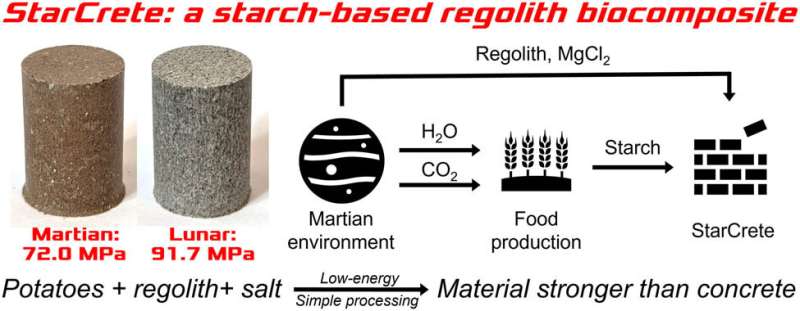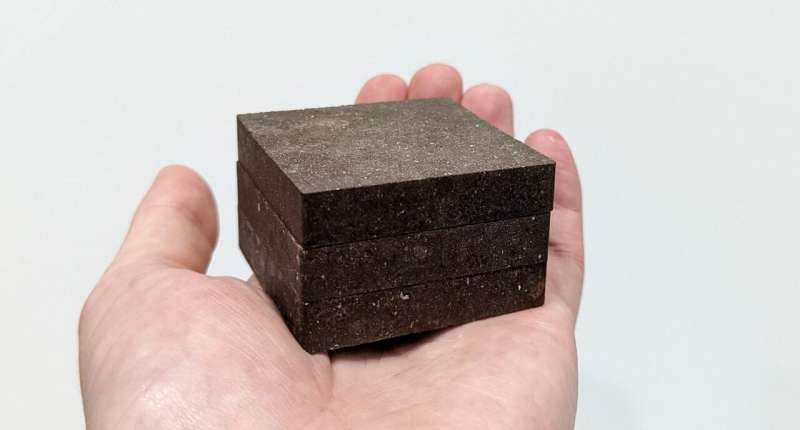Scientists develop a ‘cosmic concrete’ that is twice as strong as regular concrete

Manchester scientists have created a new material, dubbed StarCrete, which is made from extra-terrestrial dust, potato starch, and a pinch of salt and could be used to build homes on Mars.
Building infrastructure in space is currently prohibitively expensive and difficult to achieve. Future space construction will need to rely on simple materials that are easily available to astronauts, StarCrete offers one possible solution. The scientists behind the invention used simulated Martian soil mixed with potato starch and a pinch of salt to create the material that is twice as strong as ordinary concrete and is perfectly suited for construction work in extra-terrestrial environments.
In an article published in the journal Open Engineering, the research team demonstrated that ordinary potato starch can act as a binder when mixed with simulated Mars dust to produce a concrete-like material. When tested, StarCrete had a compressive strength of 72 Megapascals (MPa), which is over twice as strong as the 32 MPa seen in ordinary concrete. Starcrete made from moon dust was even stronger at over 91 MPa.
This work improves on previous work from the same team where they used astronauts’ blood and urine as a binding agent. While the resulting material had a compressive strength of around 40 MPa, which is better than normal concrete, the process had the drawback of requiring blood on a regular basis. When operating in an environment as hostile as space, this option was seen as less feasible than using potato starch.

“Since we will be producing starch as food for astronauts, it made sense to look at that as a binding agent rather than human blood. Also, current building technologies still need many years of development and require considerable energy and additional heavy processing equipment which all adds cost and complexity to a mission. StarCrete doesn’t need any of this and so it simplifies the mission and makes it cheaper and more feasible.”
“And anyway, astronauts probably don’t want to be living in houses made from scabs and urine,” said Dr. Aled Roberts, Research Fellow at the Future Biomanufacturing Research Hub, and lead researcher for this project.
The team calculate that a sack (25 Kg) of dehydrated potatoes (crisps) contain enough starch to produce almost half a ton of StarCrete, which is equivalent to over 213 brick’s worth of material. For comparison, a three-bedroom house takes roughly 7,500 bricks to build. Additionally, they discovered that a common salt, magnesium chloride, obtainable from the Martian surface or from the tears of astronauts, significantly improved the strength of StarCrete.
The next stages of this project are to translate StarCrete from the lab to application. Dr. Roberts and his team have recently launched a start-up company, DeakinBio, which is exploring ways to improve StarCrete so that it could also be used in a terrestrial setting.
If used on Earth, StarCrete could offer a greener alternative to traditional concrete. Cement and concrete account for about 8% of global CO2 emissions as the process by which they are made requires very high firing temperatures and amounts of energy. StarCrete, on the other hand, can be made in an ordinary oven or microwave at normal ‘home baking’ temperatures, therefore offering reduced energy costs for production.
More information:
Aled D. Roberts et al, StarCrete: A starch-based biocomposite for off-world construction, Open Engineering (2023). DOI: 10.1515/eng-2022-0390
Citation:
Scientists develop a ‘cosmic concrete’ that is twice as strong as regular concrete (2023, March 16)
retrieved 16 March 2023
from https://techxplore.com/news/2023-03-scientists-cosmic-concrete-strong-regular.html
This document is subject to copyright. Apart from any fair dealing for the purpose of private study or research, no
part may be reproduced without the written permission. The content is provided for information purposes only.
For all the latest Technology News Click Here
For the latest news and updates, follow us on Google News.

